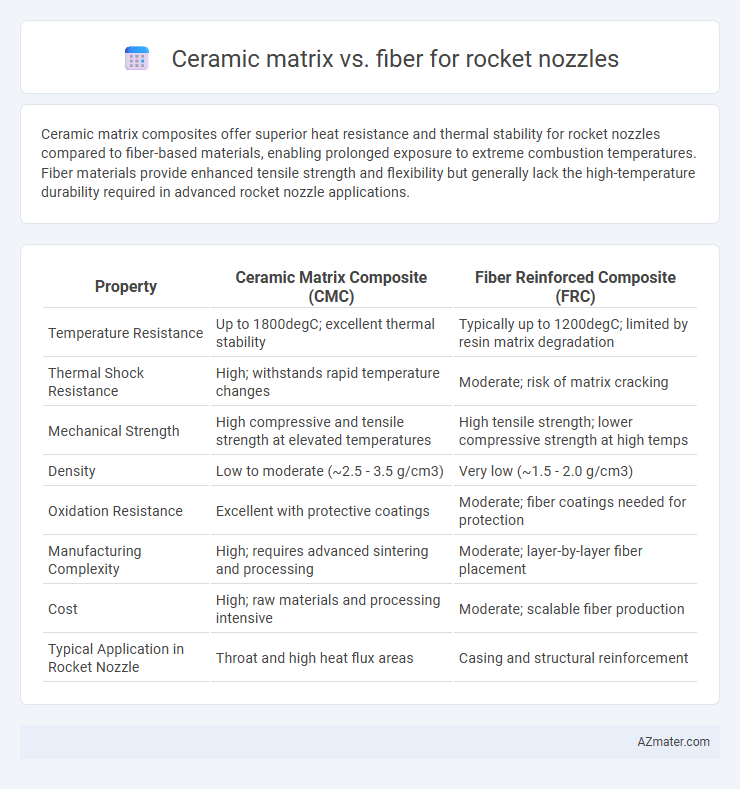Ceramic matrix composites offer superior heat resistance and thermal stability for rocket nozzles compared to fiber-based materials, enabling prolonged exposure to extreme combustion temperatures. Fiber materials provide enhanced tensile strength and flexibility but generally lack the high-temperature durability required in advanced rocket nozzle applications.
Table of Comparison
| Property | Ceramic Matrix Composite (CMC) | Fiber Reinforced Composite (FRC) |
|---|---|---|
| Temperature Resistance | Up to 1800degC; excellent thermal stability | Typically up to 1200degC; limited by resin matrix degradation |
| Thermal Shock Resistance | High; withstands rapid temperature changes | Moderate; risk of matrix cracking |
| Mechanical Strength | High compressive and tensile strength at elevated temperatures | High tensile strength; lower compressive strength at high temps |
| Density | Low to moderate (~2.5 - 3.5 g/cm3) | Very low (~1.5 - 2.0 g/cm3) |
| Oxidation Resistance | Excellent with protective coatings | Moderate; fiber coatings needed for protection |
| Manufacturing Complexity | High; requires advanced sintering and processing | Moderate; layer-by-layer fiber placement |
| Cost | High; raw materials and processing intensive | Moderate; scalable fiber production |
| Typical Application in Rocket Nozzle | Throat and high heat flux areas | Casing and structural reinforcement |
Introduction to Rocket Nozzle Materials
Rocket nozzle materials must withstand extreme thermal and mechanical stresses during engine operation, making their selection critical for performance and durability. Ceramic matrix composites offer exceptional heat resistance and low thermal conductivity, reducing cooling requirements and increasing nozzle lifespan. Fiber-reinforced materials provide high tensile strength and fracture toughness, improving structural integrity under rapid thermal cycling and mechanical loads.
Overview of Ceramic Matrix Composites (CMCs)
Ceramic Matrix Composites (CMCs) offer superior thermal resistance and lightweight properties essential for rocket nozzles operating under extreme temperatures exceeding 2000degC. These composites combine a ceramic matrix with fiber reinforcements, such as silicon carbide fibers, to enhance fracture toughness and thermal shock resistance, addressing the brittleness of traditional ceramics. Compared to metal and fiber-based materials, CMCs provide higher strength-to-weight ratios and improved durability, making them ideal for advanced aerospace propulsion systems.
Understanding Fiber-Based Materials
Fiber-based materials for rocket nozzles offer superior thermal resistance and mechanical strength compared to traditional ceramic matrix composites. High-performance fibers such as carbon, silicon carbide, and alumina reinforce the matrix, enhancing fracture toughness and thermal shock resistance essential for enduring extreme rocket exhaust temperatures. These fiber reinforcements enable improved durability and weight reduction, making them preferable for advanced aerospace thermal protection systems.
Thermal Performance: Ceramic Matrix vs Fiber
Ceramic matrix composites (CMCs) offer superior thermal resistance and can withstand temperatures exceeding 1,500degC, making them ideal for rocket nozzles exposed to extreme heat fluxes. Fiber-reinforced materials, such as carbon fibers embedded in a resin matrix, provide excellent thermal conductivity but typically maintain structural integrity only up to around 600degC to 800degC. The enhanced thermal stability of ceramic matrices allows for higher operating temperatures and improved erosion resistance in rocket nozzle applications compared to fiber-based composites.
Mechanical Strength Comparison
Ceramic matrix composites (CMCs) exhibit superior high-temperature resistance and maintain mechanical strength above 1,200degC, making them ideal for rocket nozzles exposed to extreme thermal environments. Fiber-reinforced composites, particularly those using carbon or ceramic fibers, provide enhanced tensile strength and fracture toughness, with fiber orientation significantly influencing the overall mechanical performance. Compared to fiber-only materials, ceramic matrix composites offer improved oxidation resistance and durability under thermal cycling, ensuring reliable mechanical strength during prolonged rocket engine operation.
Erosion and Ablation Resistance
Ceramic matrix composites exhibit superior erosion and ablation resistance in rocket nozzles due to their high thermal stability and resistance to oxidative degradation at extreme temperatures. Fiber-reinforced materials, while offering excellent mechanical strength and thermal shock resistance, often show increased erosion rates under high-velocity particle impacts and ablation from reactive combustion gases. Advanced ceramics such as silicon carbide (SiC) matrices combined with carbon or ceramic fibers significantly enhance durability by maintaining structural integrity and reducing material loss during prolonged rocket engine operation.
Weight and Density Considerations
Ceramic matrix composites (CMCs) offer lower density values, typically ranging from 2.5 to 3.5 g/cm3, providing significant weight savings compared to fiber-reinforced polymer composites with densities around 1.5 to 2.0 g/cm3 but lower temperature resistance. The higher specific strength and thermal stability of CMCs make them ideal for rocket nozzles exposed to extreme heat, balancing weight reduction with structural integrity. Selecting between ceramic matrix and fiber materials requires analyzing mission-specific propulsion demands and thermal loads to optimize nozzle weight and performance.
Manufacturing Techniques and Scalability
Ceramic matrix composites (CMCs) for rocket nozzles utilize advanced manufacturing techniques like slurry infiltration, chemical vapor infiltration (CVI), and hot pressing, offering high-temperature resistance and oxidation protection but facing challenges in scalability due to complex processing and lengthy production cycles. Fiber-reinforced composites, often fabricated using filament winding, fiber placement, or resin transfer molding (RTM), provide greater manufacturability with faster cycle times and easier scalability while maintaining mechanical strength and thermal stability through reinforcement with carbon or ceramic fibers. The choice between ceramic matrix and fiber composites hinges on balancing manufacturing complexity, thermal performance requirements, and production volume needs in aerospace applications.
Cost Analysis: Ceramics vs Fibers
Ceramic matrix composites (CMCs) offer higher temperature resistance and durability in rocket nozzles but come with greater material and manufacturing costs compared to fiber-based composites. Fiber composites, particularly carbon and glass fibers, provide cost-effective solutions with easier fabrication and lower weight, though they may require additional thermal protection. Cost analysis favors fiber composites for budget-sensitive projects while ceramics are preferred for high-performance, long-duration missions despite the premium price.
Future Trends in Rocket Nozzle Technology
Ceramic matrix composites (CMCs) offer superior thermal resistance and lower density than traditional fiber-reinforced composites, making them ideal for withstanding extreme rocket nozzle temperatures. Advances in fiber architecture and nano-engineered reinforcements are enhancing the mechanical strength and thermal stability of fiber-based materials. Future trends emphasize integrating CMCs with novel fiber reinforcements to optimize durability, reduce weight, and improve engine efficiency in next-generation rocket nozzles.

Infographic: Ceramic matrix vs Fiber for Rocket nozzle
 azmater.com
azmater.com